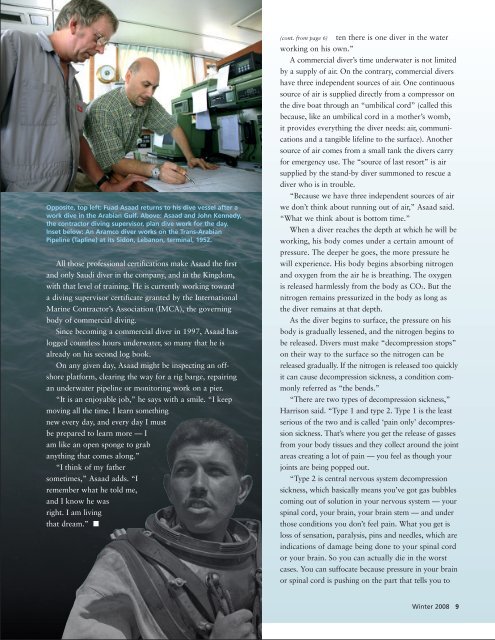Saudi Aramco Divers Thrive in Depths
Saudi Aramco Divers Thrive in Depths
Saudi Aramco Divers Thrive in Depths
Create successful ePaper yourself
Turn your PDF publications into a flip-book with our unique Google optimized e-Paper software.
Opposite, top left: Fuad Asaad returns to his dive vessel after a<br />
work dive <strong>in</strong> the Arabian Gulf. Above: Asaad and John Kennedy,<br />
the contractor div<strong>in</strong>g supervisor, plan dive work for the day.<br />
Inset below: An <strong>Aramco</strong> diver works on the Trans-Arabian<br />
Pipel<strong>in</strong>e (Tapl<strong>in</strong>e) at its Sidon, Lebanon, term<strong>in</strong>al, 1952.<br />
All those professional certifications make Asaad the first<br />
and only <strong>Saudi</strong> diver <strong>in</strong> the company, and <strong>in</strong> the K<strong>in</strong>gdom,<br />
with that level of tra<strong>in</strong><strong>in</strong>g. He is currently work<strong>in</strong>g toward<br />
a div<strong>in</strong>g supervisor certificate granted by the International<br />
Mar<strong>in</strong>e Contractor’s Association (IMCA), the govern<strong>in</strong>g<br />
body of commercial div<strong>in</strong>g.<br />
S<strong>in</strong>ce becom<strong>in</strong>g a commercial diver <strong>in</strong> 1997, Asaad has<br />
logged countless hours underwater, so many that he is<br />
already on his second log book.<br />
On any given day, Asaad might be <strong>in</strong>spect<strong>in</strong>g an offshore<br />
platform, clear<strong>in</strong>g the way for a rig barge, repair<strong>in</strong>g<br />
an underwater pipel<strong>in</strong>e or monitor<strong>in</strong>g work on a pier.<br />
“It is an enjoyable job,” he says with a smile. “I keep<br />
mov<strong>in</strong>g all the time. I learn someth<strong>in</strong>g<br />
new every day, and every day I must<br />
be prepared to learn more — I<br />
am like an open sponge to grab<br />
anyth<strong>in</strong>g that comes along.”<br />
“I th<strong>in</strong>k of my father<br />
sometimes,” Asaad adds. “I<br />
remember what he told me,<br />
and I know he was<br />
right. I am liv<strong>in</strong>g<br />
that dream.” ■<br />
(cont. from page 6)<br />
ten there is one diver <strong>in</strong> the water<br />
work<strong>in</strong>g on his own.”<br />
A commercial diver’s time underwater is not limited<br />
by a supply of air. On the contrary, commercial divers<br />
have three <strong>in</strong>dependent sources of air. One cont<strong>in</strong>uous<br />
source of air is supplied directly from a compressor on<br />
the dive boat through an “umbilical cord” (called this<br />
because, like an umbilical cord <strong>in</strong> a mother’s womb,<br />
it provides everyth<strong>in</strong>g the diver needs: air, communications<br />
and a tangible lifel<strong>in</strong>e to the surface). Another<br />
source of air comes from a small tank the divers carry<br />
for emergency use. The “source of last resort” is air<br />
supplied by the stand-by diver summoned to rescue a<br />
diver who is <strong>in</strong> trouble.<br />
“Because we have three <strong>in</strong>dependent sources of air<br />
we don’t th<strong>in</strong>k about runn<strong>in</strong>g out of air,” Asaad said.<br />
“What we th<strong>in</strong>k about is bottom time.”<br />
When a diver reaches the depth at which he will be<br />
work<strong>in</strong>g, his body comes under a certa<strong>in</strong> amount of<br />
pressure. The deeper he goes, the more pressure he<br />
will experience. His body beg<strong>in</strong>s absorb<strong>in</strong>g nitrogen<br />
and oxygen from the air he is breath<strong>in</strong>g. The oxygen<br />
is released harmlessly from the body as CO2. But the<br />
nitrogen rema<strong>in</strong>s pressurized <strong>in</strong> the body as long as<br />
the diver rema<strong>in</strong>s at that depth.<br />
As the diver beg<strong>in</strong>s to surface, the pressure on his<br />
body is gradually lessened, and the nitrogen beg<strong>in</strong>s to<br />
be released. <strong>Divers</strong> must make “decompression stops”<br />
on their way to the surface so the nitrogen can be<br />
released gradually. If the nitrogen is released too quickly<br />
it can cause decompression sickness, a condition commonly<br />
referred as “the bends.”<br />
“There are two types of decompression sickness,”<br />
Harrison said. “Type 1 and type 2. Type 1 is the least<br />
serious of the two and is called ‘pa<strong>in</strong> only’ decompression<br />
sickness. That’s where you get the release of gasses<br />
from your body tissues and they collect around the jo<strong>in</strong>t<br />
areas creat<strong>in</strong>g a lot of pa<strong>in</strong> — you feel as though your<br />
jo<strong>in</strong>ts are be<strong>in</strong>g popped out.<br />
“Type 2 is central nervous system decompression<br />
sickness, which basically means you’ve got gas bubbles<br />
com<strong>in</strong>g out of solution <strong>in</strong> your nervous system — your<br />
sp<strong>in</strong>al cord, your bra<strong>in</strong>, your bra<strong>in</strong> stem — and under<br />
those conditions you don’t feel pa<strong>in</strong>. What you get is<br />
loss of sensation, paralysis, p<strong>in</strong>s and needles, which are<br />
<strong>in</strong>dications of damage be<strong>in</strong>g done to your sp<strong>in</strong>al cord<br />
or your bra<strong>in</strong>. So you can actually die <strong>in</strong> the worst<br />
cases. You can suffocate because pressure <strong>in</strong> your bra<strong>in</strong><br />
or sp<strong>in</strong>al cord is push<strong>in</strong>g on the part that tells you to<br />
W<strong>in</strong>ter 2008 9

















